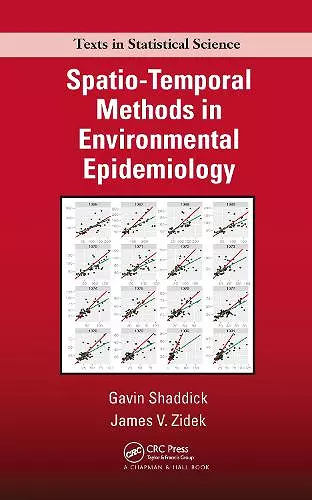Spatio-Temporal Methods in Environmental Epidemiology
Gavin Shaddick author James V Zidek author
Format:Paperback
Publisher:Taylor & Francis Ltd
Published:31st Mar '21
Currently unavailable, and unfortunately no date known when it will be back
This paperback is available in another edition too:
- Hardback£97.99(9781482237030)

Spatio-Temporal Methods in Environmental Epidemiology with R, like its first Edition, explores the interface between environmental epidemiology and spatio-temporal modelling. It links recent developments in spatio-temporal theory with epidemiological applications. Drawing on real-life problems, it shows how recent advances in methodology, can assess the health risks associated with environmental hazards. The book's clear guidelines enable the implementation of the methodology and estimation of risks in practice. New additions to the second edition include : a thorough exploration of the underlying concepts behind knowledge discovery through data; a new chapter on extracting information from data using R and the Tidyverse; additional material on methods for Bayesian computation, including the use of NIMBLE and Stan; new methods for performing spatio-temporal analysis and an updated chapter containing further topics. Throughout the book there are new examples and the presentation of R code for examples has been extended. Along with these additions, the book now has a GitHub site (https://spacetime-environ.github.io/stepi2) that contains data, code and further worked examples.
Features
• Explores the interface between environmental epidemiology and spatio temporal modelling;
• Incorporates examples that show how spatio-temporal methodology can inform societal concerns about the effects of environmental hazards on health;
• Uses a Bayesian foundation on which to build an integrated approach to spatio-temporal modelling and environmental epidemiology;
• Discusses data analysis and topics such as data visualization, mapping, wrangling and analysis
• Shows how to design networks for monitoring hazardous environmental processes networks and the ill-effects of preferential sampling;
• Through the listing and application of code, shows the power of R, tidyverse, NIMBLE and Stan and other modern tools in performing complex data analysis and modelling.
Representing a continuing important direction in environmental epidemiology, this book -- in full color throughout -- underscores the increasing need to consider dependencies in both space and time when modelling epidemiological data. Readers will learn how to identify and model patterns in spatio-temporal data and how to
exploit dependencies over space and time to reduce bias and inefficiency when estimating risks to health.
"The authors of this text, both accomplished researchers in the area, provide a much-needed consolidation of spatio-temporal modelling methods…The textbook condenses many complex topics into accessible and manageable chapters addressing key elements of modern spatio-temporal analyses of environmental epidemiologic data…The authors provide helpful R examples throughout…Analytic challenges such as missing data, measurement error, and preferential sampling often arise in environmental epidemiology and are each described in detail along with focused data examples and accompanying code…The text covers a remarkable number of topics in its 318 pages (including many full color graphics and examples of code and output). The structure outlined above provides excellent coverage of many areas of recent development, held together with compelling examples and illustrations…Overall, I found the book a comprehensive overview placing many different topics into a logical perspective with focused, helpful examples. I enjoyed reading the book, am already recommending it to colleagues, and anticipate referring to it often in my future work."
—Lance A.Waller, Emory University, The American Statistician, November 2016
"The authors of this text, both accomplished researchers in the area, provide a much-needed consolidation of spatio-temporal modelling methods…The textbook condenses many complex topics into accessible and manageable chapters addressing key elements of modern spatio-temporal analyses of environmental epidemiologic data…The authors provide helpful R examples throughout…Analytic challenges such as missing data, measurement error, and preferential sampling often arise in environmental epidemiology and are each described in detail along with focused data examples and accompanying code…The text covers a remarkable number of topics in its 318 pages (including many full color graphics and examples of code and output). The structure outlined above provides excellent coverage of many areas of recent development, held together with compelling examples and illustrations…Overall, I found the book a comprehensive overview placing many different topics into a logical perspective with focused, helpful examples. I enjoyed reading the book, am already recommending it to colleagues, and anticipate referring to it often in my future work."
—Lance A.Waller, Emory University, The American Statistician, November 2016
ISBN: 9780367783464
Dimensions: unknown
Weight: 680g
395 pages